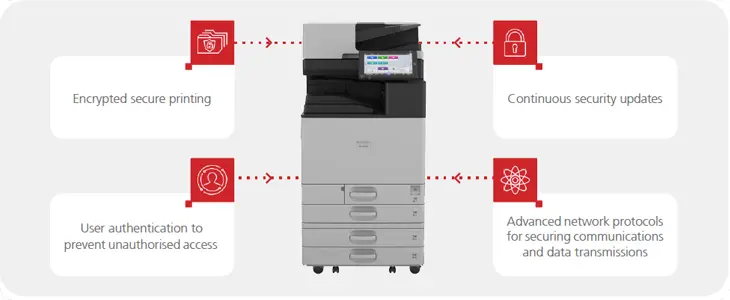Printing isn't just about putting ink on paper; it's about moving information between digital and physical formats so work can flow smoothly. Modern workplaces need efficient document management, and businesses need print technology to enable this for their users. This technology should boost productivity, support sustainability goals, and support overall IT strategy.
Laser vs Inkjet: The print technology choice
Laser printing has long been the gold standard for business environments, but as technologies evolve and advance, it's worth reviewing whether this still holds true.
Research in our recent white paper reveals that laser technology maintains a distinct advantage over inkjet technology when implemented as part of a well-structured data-flow strategy.
In this article, we'll break down why laser printing remains the right choice for modern enterprises, focusing on:
- Productivity and speed
- Print quality and durability
- Cost efficiency and sustainability
And we’ll also take a look at how to securely integrate your print solution into your organisation to protect your data, whatever print technology you choose.
Let's explore how choosing the right print technology can help your business work smarter.

Productivity and Speed: Office printing efficiency
Fast-flowing information is essential for businesses. Every delay in accessing, printing, or sharing documents can disrupt workflows and reduce efficiency. Print delays can lead to missed deadlines, frustrated employees, and slower decision-making, impacting overall business performance.
DataMaster's independent testing confirms that laser printers outperform inkjets in real-world business applications in high-demand office environments. While inkjet printers struggle with speed consistency and require time for ink to dry before handling, laser printers deliver rapid, high-volume performance without compromising quality. This makes Laser the preferred choice for industries where efficiency is critical, such as finance, healthcare, and legal sectors.
Additionally, laser printers handle complex documents more quickly, so high-resolution images, detailed reports, and double-sided prints are produced without slowdowns.
Key Points for Print Productivity:
- Faster Output: Laser printers maintain their rated speed across different document types. Inkjets slow down for complex prints, sometimes taking up to 141% longer to complete a job than laser printers, according to DataMaster Labs.
- Instant-Dry Prints: Unlike inkjet prints that require drying time, laser prints are ready to use immediately, reducing workflow bottlenecks and increasing efficiency.
- High-Volume Performance: Businesses handling large print jobs benefit from laser printers' ability to process multiple print jobs without performance drops.
- Better Document Handling: Laser printers efficiently manage high-resolution and double-sided documents without delays or smudging, ensuring high productivity.
A seamless, efficient print workflow is essential for businesses transitioning to hybrid work models. Employees must print quickly from multiple locations without disruption, making Laser the preferred choice for enterprise-grade printing.
Print Quality and Durability: The Business Impact
Your printed materials represent your business. Consistency in print quality is essential, from contracts and proposals to marketing collateral. A poor-quality print can impact client perceptions and internal communications, so choosing a printing solution that guarantees clarity and reliability is crucial.

In our recent whitepaper, independent testing shows that laser printers deliver consistent, professional-quality output that ensures every document reflects your business's high standards. Unlike inkjet prints, which can be susceptible to smudging and uneven colour distribution, laser prints maintain precision and uniformity across all materials.
Additionally, laser printing ensures better longevity for essential business documents. Since toner is fused onto the page rather than absorbed like ink, prints remain sharp and resistant to environmental factors such as humidity or fading over time. Laser printers are ideal for long-term document storage, compliance records, and professional-quality materials.
Key Points for Print Quality:
- Sharper Text & Graphics – Laser technology ensures precise toner placement, delivering 91/100 print quality ratings compared to 76/100 for inkjet.
- Smudge & Water Resistance – Laser prints are moisture-resistant, making them ideal for long-term documents and professional materials.
- Better Media Handling – Whether you're printing on standard office paper or heavier cardstock, laser prints retain quality across all formats.
- Long-Term Document Integrity – Toner prints remain clear and legible over time, making them ideal for compliance, records, and archival use.
Laser printing provides unparalleled reliability for industries such as finance, healthcare, and legal services, where accuracy and print longevity are critical.
Cost Efficiency and Sustainability: Smart Printing for the Future
While inkjet printers often come with lower upfront costs, they can lead to higher long-term expenses from frequent cartridge replacements, higher ink consumption, and increased maintenance.

Our Business Guide to Print Technologies White paper highlights that inkjet printers require more servicing over their lifespan, which adds to operational costs. Additionally, businesses printing high volumes may experience inkjet performance degradation over time, leading to inefficiencies and delays.
Laser printing offers significant cost benefits, especially when optimised for sustainability. Laser printers use high-yield toner cartridges, which last significantly longer than ink cartridges and contribute to reduced waste.
Testing by DataMaster Labs says laser printers maintain consistent print quality across a higher page yield, ensuring businesses get the most out of every toner refill. Moreover, innovations like Ricoh's induction fuser technology further improve energy efficiency, lowering long-term operational expenses while supporting sustainability goals.
Key Benefits for Print Cost Reduction
- Lower Cost Per Page – Laser printers use high-yield toner cartridges that last significantly longer than ink cartridges, reducing replacement frequency and costs.
- Energy Efficiency – Ricoh's induction fuser technology reduces power consumption, lowers operational expenses, and supports sustainability initiatives.
- Better Paper Efficiency – Laser printers make high-speed duplex printing (double-sided printing) faster and more efficient, reducing paper waste and minimising environmental impact.
Additionally, laser prints are more recyclable, as toner sits on the paper's surface rather than soaking into the fibres, making recycling more efficient than inkjet prints.
Beyond the Printer: Ensuring Security and Integration in Your Print Strategy
Whatever technology you choose, protecting business information is more critical than ever. With rising cybersecurity threats and stricter data regulations, companies must take a holistic approach to print security that goes beyond device selection. Security concerns don't stop at the printer—businesses must consider user access, document handling, and network vulnerabilities.
Implementing secure print release solutions, which require users to authenticate at the device before printing, helps prevent sensitive documents from being left unattended.

Additionally, advanced encryption and data protection measures ensure that information remains secure during transmission and storage. These security measures can help ensure compliance with industry regulations such as GDPR and HIPAA, which require strict controls over document access and storage.
Companies should also consider cloud print management, allowing IT teams to monitor and control printing activity remotely, reducing risks associated with unmanaged print environments.
By integrating print security with broader enterprise security policies, businesses can ensure that printing remains a controlled and secure aspect of their workflow.
Key Points for Print Security and Strategy:
- Secure Print Release – Ensure documents are only printed when authorised users are present, reducing data exposure.
- End-to-End Encryption – Protects sensitive information during transmission and storage, minimising cybersecurity risks.
- Cloud-Based Print Management – Provides IT teams greater visibility and control over print activity, reducing vulnerabilities.
- Compliance & Risk Management – Helps businesses adhere to data protection regulations by ensuring secure document handling.
- Managed Print Services – Managed Print Services use the expertise of the print provider to provide the ongoing management, maintenance, and optimisation of an organisation’s print infrastructure.
Conclusion: Choosing the Right Print Solution for Your Business
The role of print in the workplace is changing, but its value remains in the execution, not just the device itself. Laser printers are more efficient, cost-effective, and secure and are key enablers in the movement of information.
But print technology alone isn't enough. A successful print strategy must align with broader hybrid work models, automation initiatives, and security frameworks.
Ready to make an informed decision on your print technology?
Download Ricoh's latest business guide on print technologies to explore how laser solutions can drive intelligent workflows in your organisation.
Download the Guide
Let’s connect
Talk to a Ricoh expert. Find out how we can help you streamline workflows and automate processes for higher efficiency and productivity.
Recommended resources for you

The Business Guide to Print Technologies
Our whitepaper on print technologies will help you to understand which printer is best for your business and office use.

Building A Smarter Print Strategy For The Future
Learn how Hent transformed their print strategy with RICOH Smart Integration, streamlining workflows and boosting efficiency for their construction projects.

The Definitive Guide to Selecting the Right Managed Services Partner
Learn the six critical factors in choosing the right managed service partner and how they can support a business’s IT infrastructure.


